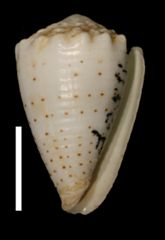Project 2642: U. E. Smith, J. R. Hendricks. 2013. Geometric Morphometric Character Suites as Phylogenetic Data: Extracting Phylogenetic Signal from Gastropod Shells. Systematic Biology. 62 (3):366-385.
Abstract
Despite being the objects of numerous macroevolutionary studies, many of the best represented constituents of the fossil record—including diverse examples such as foraminifera, brachiopods, and mollusks—have mineralized skeletons with limited discrete characteristics, making morphological phylogenies difficult to construct. In contrast to their paucity of phylogenetic characters, the mineralized structures (tests and shells) of these fossil groups frequently have distinctive shapes that have long proved useful for their classification. The recent introduction of methodologies for including continuous data directly in a phylogenetic analysis has increased the number of available characters, making it possible to produce phylogenies based, in whole or part, on continuous character data collected from such taxa. Geometric morphometric methods provide tools for accurately characterizing shape variation and can produce quantitative data that can therefore now be included in a phylogenetic matrix in a nonarbitrary manner. Here, the marine gastropod genus Conus is used to evaluate the ability of continuous characters—generated from a geometric morphometric analysis of shell shape—to contribute to a total evidence phylogenetic hypothesis constructed using molecular and morphological data. Furthermore, the ability of continuous characters derived from geometric morphometric analyses to place fossil taxa with limited discrete characters into a phylogeny with their extant relatives was tested by simulating the inclusion of fossil taxa. This was done by removing the molecular partition of individual extant species to produce a “cladistic pseudofossil” with only the geometric morphometric derived characters coded. The phylogenetic position of each cladistic pseudofossil taxon was then compared with its placement in the total evidence tree and a symmetric resampling tree to evaluate the degree to which morphometric characters alone can correctly place simulated fossil species. In 33–45% of the test cases (depending upon the approach used for measuring success), it was possible to place the pseudofossil taxon into the correct regions of the phylogeny using only the morphometric characters. This suggests that the incorporation of extinct Conus taxa into phylogenetic hypotheses will be possible, permitting a wide range of macroevolutionary questions to be addressed within this genus. This methodology also has potential to contribute to phylogenetic reconstructions for other major components of the fossil record that lack numerous discrete characters.Read the article »
Article DOI: 10.1093/sysbio/syt002
Project DOI: 10.7934/P2642, http://dx.doi.org/10.7934/P2642
| This project contains |
|---|
Download Project SDD File |
Currently Viewing:
MorphoBank Project 2642
MorphoBank Project 2642
- Creation Date:
17 March 2017 - Publication Date:
30 June 2017
Authors' Institutions ![]()
- Paleontological Research Institution, Ithaca
- Cornell University
- San Jose State University
Members
| member name | taxa |
specimens |
media |
| MorphoBank Curator Project Administrator | 1 | 1 | 1 |
Project has no matrices defined.
Project downloads 
| type | number of downloads | Individual items downloaded (where applicable) |
| Total downloads from project | 257 | |
| Project downloads | 248 | |
| Document downloads | 9 | Continuous data (9 downloads); |

